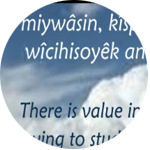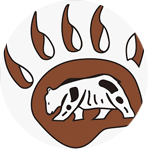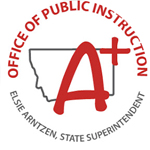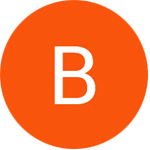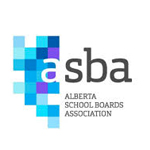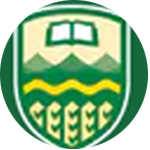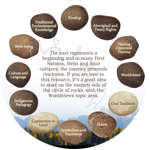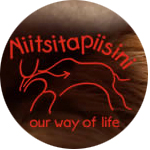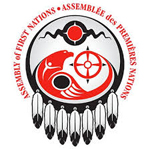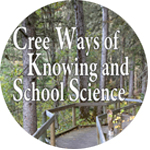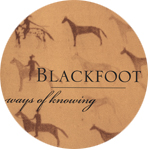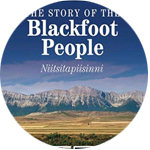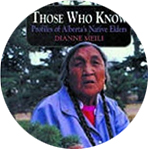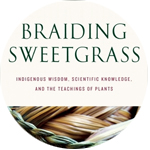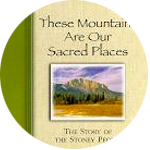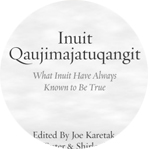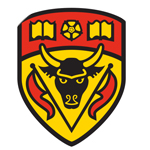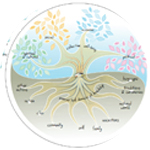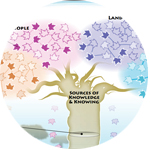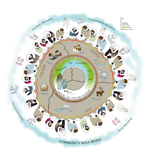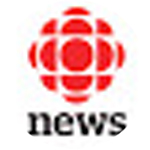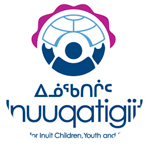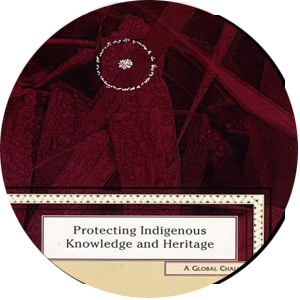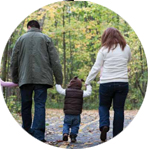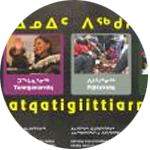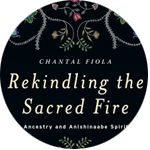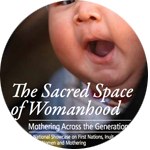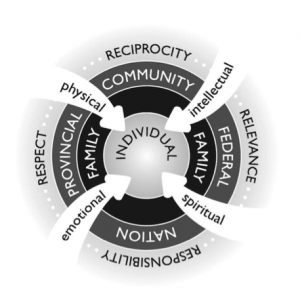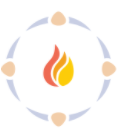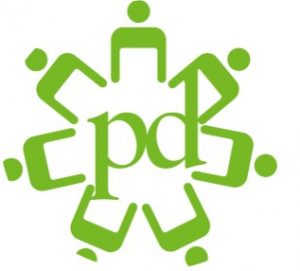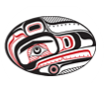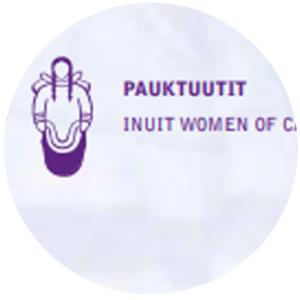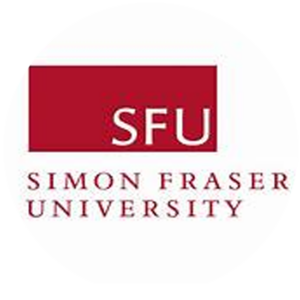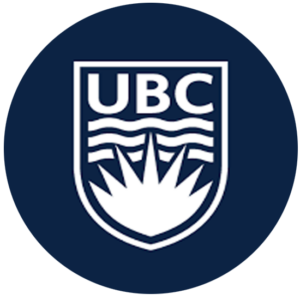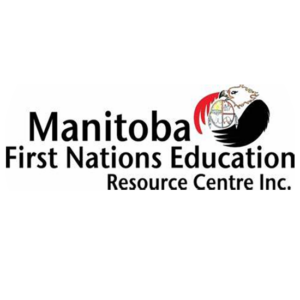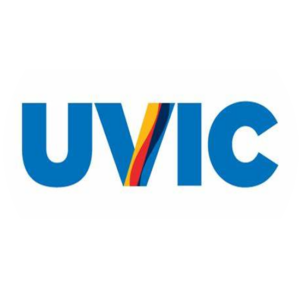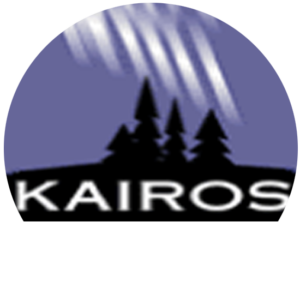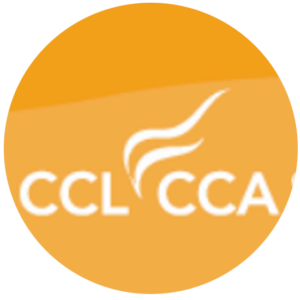Teachings
In this section, you will learn about the importance of the diversity of Indigenous Peoples teachings which include ways of knowing, being and doing.
Introduction
Indigenous teachings encompass ways of knowing, being, and doing that are actively practiced or learned. Teachings is the English word used to describe the process of sharing knowledge or original Indigenous methods of educating. Original practices and teachings are distinct to each diverse Indigenous group and continue despite centuries of legal and extralegal oppression and demonizing such as forced assimilation laws, policies, attitudes, beliefs and practices rooted in genocide that are inflicted on Indigenous Peoples. The more one understands Indigenous Peoples through our relationships with each other, language, and the land the more it is evident that Indigenous knowledge systems and methods of educating are rich and necessary. Lifelong learning is continual and includes many kinds of teachers that extend beyond the walls and halls of schools which includes learning from the land.
The idea perpetuated by many non-Indigenous peoples was that Indigenous Peoples lacked knowledge and morals. This was and is untrue but was used to validate land acquisition, assumed superiority, and control over the original peoples of this land. Indigenous Peoples were not empty vessels roaming the lands aimlessly waiting to be saved and conquered. Sovereign Indigenous nations thrived and flourished with each other and the land through sophisticated social governance methods, kinship systems, child-rearing practices, deep spirituality, and knowledge of and respect for the natural world that surrounds them. Indigenous knowledge systems contributed to the first newcomers’ survival on this land, yet this piece of history is often disregarded or diluted. Educator Yatta Kanu says that to repair the damage that has been done, “teacher education programs have to address colonialism and racism as well as [Indigenous Knowledge].”1
Ways of Knowing
Forcible disconnection from culture was legislated by the government. Indigenous languages embed ways of knowing and knowledge which includes knowledge of the natural world and how to live in balance with it and one another.2 The colonization policy, the Indian Act ,banned ceremonies which contributed to the disconnection of generations learning of the richness of Indigenous knowledge systems, identity and language.3 The Aboriginal Healing Foundation explains that “Indigenous worldviews are centered on the idea of interconnectedness, and thus, all things are connected: the present, past, and future; all people and all of creation; individuals and their kin; and within oneself, the spirit, heart, body, and mind. Many Indigenous cultures focus on teachings from the circle, which represents connection and balance within a system of ongoing change.”4 Pedagogies inherent to original Indigenous ways of knowing can be woven into Alberta curriculums and will enhance all students’ sense of well-being. ” Holistic” approaches to teaching can engage students with different learning styles.5
Knowledge transference has been severed due to genocidal policies such as the Residential School system. Indigenous leaders have always valued education, and some believe that the original spirit and intent of treaties encompassed sharing knowledge with one another in a good way rather than the one-sided Eurocentric, paternalistic and institutionalized methods that were enforced. Children were taught that their knowledge was not worthy, to be ashamed and encouraged to disown original Indigenous methods of thinking, being, and doing. Psychological, spiritual, emotional, and physical damage has impacted generations. Short- and long-term impacts of this damage is used to justify continued racism, violence, and belittling of Indigenous Peoples. Although intergenerational effects of genocidal policies continue to impact learners it is important to acknowledge and make systematic changes to address current colonialism and anti-Indigenous racism within educational leadership, teachers, students curriculum and policies.
Distinct Teachings
Although the term Indigenous is widely used as a blanket term to describe all First Nations, Métis and Inuit , it is important to understand that there are many distinct Nations with distinct teachings that have shaped Nations from time immemorial. In what is now Alberta alone there are 49 First Nations, 140 reserves, over 114K self-identified Métis people in Alberta, approximately 50K Métis Nation of Alberta citizens, and 6 500 on the 8 Métis settlements in Alberta, and 2500 Inuit.6 Indigenous Peoples live across the province, and each person has their own personal story. The distinct teachings of people and nations across Alberta emphasize the need to use local learning. There are digital or print related resources written by Indigenous People that feature teachings, but learning from nations and individuals is the most genuine way to enhance one’s understanding of ways of being, knowing and doing.
First Nations
Betty Bastien emphasizes the need for accessing local knowledge when she says “knowledge depends on relationships learned in childhood and is relational”.7 Original Indigenous methods of educating children extend beyond the walls of indoor space. Leroy Littlebear explains that “learning is viewed as sacred and holistic, as well as experiential, purposeful, relational, and a life-long responsibility.”8 Education was woven into daily lives and the environment that sustained Indigenous Peoples. Ceremonies continue to enrich and strengthen Nations and individuals. Practicing ceremony and balancing original ways of living with current contexts has enabled survival during colonization and will ensure thriving into the future. Each Nation has ways to teach how to live a good life.
For example, Janet Fox (Maskwacis) describes a Cree teaching embedded within the structure of a tipi. “The Fifteen Teepee Pole teachings were a way of sharing fifteen important values or virtues with children. Each teepee pole represents a value and teaching that is paired with that value. The teepee was the first classroom. The teachings follow Wahkohtowin or natural law.”9 To deeply learn more about teachings such as this, please connect with Elders or Knowledge Keepers and learn within the space of the tipi or other cultural place of education. Creating and sustaining relationships with those providing experiential learning opportunities involving teaching is essential.
In the Indigenous world, knowledge is relationships.10 Many schools will turn to the 7 Sacred Teachings as a starting point. These teachings originate with the Anishinaabe and there are parallels of these teachings with many First Nations. It is important to connect with local First Nations to find out teachings and protocols that are reflective of their original methods of teaching about character values and morals.
Métis
Traditions and teachings are unique to the Métis with strong roots connecting Indigenous and non-Indigenous ways of being. The Métis Nation of Alberta states:
Métis holistic perspectives require consideration of the many facets of life of a people, including the traditional knowledge that has sustained them over generations. Métis understand the environment as sacred relationships linking such things as language, learning, people and social structures, traditions, land (including all parts of the Earth and atmosphere), spirituality, self-development, harmonious interactions, Indigenous knowledge, health, imagination, economic conditions, balanced approaches to life, political systems, and values.11
Amidst the unity of the Métis Nation ,there is diversity in how people practice their teachings and traditions. An example of a tradition that some may or may not follow includes celebration of newborns into the communities:
There were also various practices observed once the umbilical cord has fallen off the bay. In Métis communities, they collected the belly button and placed it in a special medicine pouch that was tied to that baby’s cradleboard or it was buried under a tree. That tree would become the family tree. When the baby was born , it was to celebrate the birth of new life into the world. Many people would come and visit with the mother and child and introduce themselves to that new spirit. The role of the Elders within the community was very important at birth.” 12
The Métis sash, the flag, the distinctive Red River jig, and the Red River Cart all have significant symbolism and history. To learn more about Métis teachings, connect with Métis People, communities, and organizations and refer to the resources listed below.
Inuit
Inuit continue to have close ties to the land and consider their relationship to the land to be essential to their culture and to their survival as a distinct people.” 13 As stewards of the land, Inuit continue to hunt and fish which has sustained a way of life in the Arctic for generations.
Despite a changing landscape and colonial assimilation policies, the strength and resilience of Inuit culture remains and continues to thrive. Inuit history, teachings, stories, kinship, and celebrations are expressed through traditional clothing, drum dancing, song, jigging, and throat signing. Inuit honour loved ones through the continuation of traditional naming practices, and recognize identity, strength, and womanhood through kakinniit, the traditional practice of Inuit tattooing.
Inuit across Nunangat are united in the values of kinship and Inuit Qaujimajatuqangit, which describes Inuit epistemology or ways of knowing and being working for a common good, respecting all living things, maintaining harmony and balance, and continuously planning and preparing for the future.
Inuit culture is included in all activities of northern life, for example children are taught Inuvialuktun or Inuktitut and learn traditional games and crafts at home and in educational settings. School curriculum includes a focus on culture, language, land-based learning, history and current issues impacting Inuit way of life.
To learn more about Inuit teachings, connect with people, communities and organizations and refer to the resources listed below.
Decolonizing Education
University of Victoria Centre for Youth & Society:
“Decolonization is the process of undoing colonization practices. Within the educational context, this means confronting and challenging the colonizing practices that have influenced education in the past, and which are still present today. In the past, schools have been used for colonial purposes of forced assimilation. The TRC reports remind us that residential schools were specifically designed to colonize the mind, the heart, and the spirit. Nowadays, colonialism is more subtle, and is often perpetuated through curriculum, power relations, and institutional structures. Perhaps the most essential part of decolonization is continual reflection. Schools should be willing to reflect on curriculum, power dynamics, their own structuring, and any action undertaken on behalf of their students.”14
State of Equity In Education Report highlights evidence-based strategies for the development and implementation of equity based policies, practices and programs for Indigenous students enrolled in the public schools of Winnipeg . The report recommends that concrete and authentic change comes from addressing deeply embedded systemic issues of colonialism and racism, engaging in difficult conversations and being transparent and accountable to the community.15
Reciprocity
When seeking gifts of teaching, knowledge, advice, and guidance it is important to practice reciprocity. “Reciprocity acknowledges a mutual exchange of benefits or privileges and is expressed through the act of exchanging gifts.”16 Exchanging gifts can mean different things to Indigenous Peoples. For example, reciprocity can come in many forms such as honorarium, contractual agreements, employment, material gifts, and as formal acknowledgement. It is important to communicate with those you are seeking knowledge or guidance from to find out if there are specific protocols to follow when asking for the sharing of knowledge, information, or advice. One example includes that of many First Nations following traditional protocols of offering tobacco and gifts to begin relationships. Many Indigenous Peoples have teachings around reciprocity and protocols that extend beyond relationships with people. For example, some First Nations may practice the tradition of offering tobacco and prayer as a thank you to the earth when medicines, plants, or flowers are harvested. Not all Indigenous Peoples practice reciprocity in this way therefore it is important to connect with the First Nations, Métis or Inuit people in which you are seeking knowledge from so as to know what protocols to follow or practice. Reciprocity is an important elements for building and maintaining good relationships.
Reciprocity to support Indigenous students is also used within a 4R’s framework : Respecting Indigenous knowledge, Responsible relationships, Reciprocity, and Relevance.17 Reciprocity within this model includes sharing knowledge through the entire education process and learning together with Indigenous people. The 4 R’s framework has been used to develop guides to support Indigenous Student learning. To support the diversity of Indigenous knowledge from First Nations, Métis, and Inuit perspectives the Canadian Council of Learning produced State of Aboriginal Learning in Canada: A holistic approach to measuring success. According to the Organisation for Economic Co-operation and Development (OECD) report Promising Practices in Supporting Success for Indigenous Students states practices benefit both Indigenous and non-Indigenous students.18
The resources listed in relation to teachings are entry points into further learning, which is best done through connecting and learning from people.
Reflection
1. What is one action that you believe needs to be implemented in your district to support decolonized education to better meet the learning needs of Indigenous students?
2. How can learning about Indigenous teachings (ways of knowing, being, doing) facilitate your leadership actions towards education for reconciliation?
3. What actions can you take to connect with Indigenous Peoples to enhance your understanding of teachings while creating lasting relationships?
4. Go further and learn about how pedagogies that align with original Indigenous ways of educating can enhance all students’ sense of well-being. How would you design and implement a holistic model of teaching and learning in your district?
5. What systemic practices that you have read about would contribute to the success for both Indigenous and non-Indigenous students?
Related Resources
A version of traditional Cree teachings about parenting, the mossbag and the swing are shared through this digital story.
This video playlist features many videos with specific Cree teachings from mossbag teachings, birth, smudging, four laws, pipe and others.
The Sacred Relationship explores how reconciling the relationship between Aboriginal People and the rest of Canada can lead to healthier water.
A variety of short videos that speak to topics including “Sacred Relationships, Creation Stories, People of the Land, Ceremony and Identity, and more. Educators can download lesson plans to accompany each video.
Learn about some aspects of Métis Culture.
These cards are downloadable or can be pulled up on your screen.
Authentic engaging lesson plans that speak to five foundational knowledge themes in Métis Education.
A lecture on how Blackfoot pedagogies influenced Maslow’s hierarchy of needs.
Narcisse Blood speaks to the connection of language and worldview from a Blackfoot perspective.
Dr. Leroy Little Bear speaks to Indigenous Knowledge and Western Science.
Jerry and Jo-Ann Saddleback: Traditional Concepts of Family and Community. A video touching on traditional concepts of family and community.
A video that introduces Cree traditional woman’s teachings.
ASBA Indigenous Advisory Circle Members discuss the Indigenous worldview and how to bring that into the classroom.
ASBA Indigenous Advisory Circle members discuss Indigenous culture. In order to reach understanding, it is important to retain the Indigenous way of life and to share it with others.
ASBA Indigenous Advisory Circle Elders talk about the importance of the family in Indigenous culture; how it facilitates the passing on of values, traditions and ceremony.
ASBA Indigenous Advisory Circle Elders explore the importance of keeping the oral tradition alive and in teaching the next generation about this tradition.
In this introductory module, students learn the significance of stories and storytelling in Indigenous societies. We explore history that comes from Indigenous worldviews, this
includes worldviews from the Inuit, Nehiyawak, Kanien:keha’ka and Tlingit Peoples.
A print and web version of this resource includes contemporary and historical photography, maps and written descriptions on a variety of topics written by Indigenous Peoples.
This interactive digital professional development resources touches on many foundational knowledge topics. This section focuses on Developing an understanding of the diversity of worldviews within First Nations, Métis and Inuit cultural and linguistic groups in Alberta.
This interactive site supports the Glenbow Museums learning initiatives. “It features Blackfoot way of life; how we lived with our families; the environment; and
neighbours. It is also about how these relationships are still important to us.”
This paper discusses Indingeous Knowledge systems.
A book designed to assist educators in coming to understand the larger frameworks of Cree ontology (ways of seeing the world and one’s place in it), epistemology (ways of understanding knowledge), and methodologies (ways of teaching).
A journey into Blackfoot cultural ways of understanding and experiencing the world, the author shares her personal story of “coming home” to reclaim her identity .
This book chronicles aspects of Blackfoot life and history . Fundamental belief systems,including traditional stories, sacred places, dances and ceremonies are included. Strong relationships as one of the most important keys to survival are examined in detail.
The Elders in Those Who Know have devoted their lives to preserving the wisdom and spirituality of their ancestors. Despite insult and oppression, they have maintained sometimes forbidden practices for the betterment of not just their people, but all humankind.
The awakening of ecological consciousness requires the acknowledgment and celebration of our reciprocal relationship with the rest of the living world.
This book provides a glimpse into worldview, values, beliefs, and aspirations of the Nakoda or Stoney People.
Inuit Qaujimajatuqangit means all the extensive knowledge and experience passed from generation to generation . The book is a collection of contributions by well- known and respected Inuit Elders as a way of preserving important knowledge and tradition, contextualizing that knowledge within Canada’s colonial legacy and providing an Inuit perspective on how we relate to each other, to other living beings and the environment.
This document gives insight into “What is the protocol to follow when inviting an Elder, knowledge keeper or cultural advisor to participate in your meetings or events?”
Poo’miikapii: Niitsitapii Approaches to Wellness is a topic (4-courses, 12 units) offered as part of the Interdisciplinary Master of Education (MEd) program. Centered in Niitsitapii (Blackfoot) ways of knowing, being, and doing in relation to poo’miikapii (harmony, balance,unity).
Weaving Ways is intended to be a complimentary guide for educators who are deepening their foundational knowledge and educational approaches to foster reconciliation.
An infographic that teaches to the concept of learning as holistic from a First Nations perspective.
An infographic that teaches to the concept of learning as holistic from a Métis perspective.
An infographic that teaches to the concept of learning as holistic from an Inuit perspective.
Meet Elders from across Canada as they answer your inquiries.
This series gives insights into a variety of topics as well provides the opportunity for you to ask specific questions.
This video gives insight into the significance of the Inuit practice of “Lighting the Qulliq”
The National Representational Organization Protecting and Advancing the Rights and Interests of Inuit in Canada<
A facilitator guide: Parent workshop on Parent-Child Attachment which includes examples of traditional parenting techniques from nations across Canada.
“In Rekindling the Sacred Fire, Chantal Fiola investigates the relationship between Red River Métis ancestry, Anishinaabe spirituality, and identity, bringing into focus the ongoing historical impacts of colonization upon Métis relationships with spirituality on the Canadian prairies.”
A background report featuring First Nations, Inuit and Métis Women and Mothering across the generations
Although there are many diverse Indigenous Peoples in Canada, there is some commonality among ways of knowing and being. This article provides a good overview of holistic learning and why it is important to Indigenous student and staff success and safety. In previous educational jargon, we talked about the 3 Rs, reading , writing and arithmetic while many Indigenous Peoples would describe the 4 Rs, respect, responsibility, relevance and reciprocity as guiding success.
The National Centre for Collaboration in Indigenous Education (NCCIE) is hosted by the First Nations University of Canada, which has a 40-year history of being Indigenous-owned, operated, and controlled. The Centre is grounded in principles of respect, reciprocity, and relationship, which are understood in Indigenous ways and honoured according to Indigenous protocols and customs. The NCCIE has excellent resources (articles, podcasts, teacher materials, research) from all across Canada on Indigenous perspectives, land-based learning, languages, maps, reconciliation, etc.
Learn how storytelling, a traditional way of sharing the culture and values of a community, remains a valuable teaching tool for today.
This brief article speaks to the importance of understanding the difference between Indigenous and western Worldviews to successfully build cultural harmony and respectful relationships.
Pauktuutit fosters greater awareness of the needs of Inuit women, advocates for equity and social improvements, and encourages their participation in the community, regional and national life of Canada.
A Curriculum Development Tool for Inclusion of First Nation, Métis and Inuit Perspectives Throughout Curriculum
AB Ed. (2001). This resource will help classroom teachers and staff better serve the
needs of their Indigenous students.
The role of Indigenous knowledge in supporting wellness in Inuit communities in Nunavut
Downloadable Metis Culture with information about the Metis flag, beadwork and embroidery, fiddle, sash, red river cart, red river jig, and cuisine.
Downloadable Metis Culture with information about the Metis flag, beadwork and embroidery, fiddle, sash, red river cart, red river jig, and cuisine.
RLI’s Education Team has developed engaging lesson plans based on the Five Foundational Knowledge Themes. Educators have the opportunity to build their foundational knowledge while delivering Métis content through lessons that reflect promising practices.
This collection of seven short digital stories introduces viewers to a selection of Métis stories as told through a variety of community perspectives, including intergenerational tellings which are unique to these stories. The digital stories feature Sputinow (Fishing Lake Métis Settlement) during 2010 and 2011 and formed the basis for an academic dissertation undertaken by Yvonne Poitras Pratt.
Simon Fraser University. INDIGENOUS CURRICULUM RESOURCE CENTRE. Features summaries, recommended articles, nooks and research in relation to Indigenous Curriculum
Indigenous Storywork is the result of this research and it demonstrates how stories have the power to educate and heal the heart, mind, body, and spirit. Jo-ann Archibald. Published 2008 by UBC Press
Linda May Goulet author Keith N. Goulet. Provides an alternative framework for teachers working with Indigenous students in Canada. Vancouver : UBC Press 2014
Directions for PBE with respect to decolonization and reinhabitation—and the meaningful acknowledgement of Indigenous knowledge systems—are explored. Implications for teacher education are addressed.
Tipiskawi Kisik: Night Sky Star Stories by Wilfred Buck, (Manitoba First Nations Education Resource Center, 2018) An exploration of stars and constellations—and their associated mythologies—will greet you with age-old knowledge held by Indigenous people prior to European contact.
University of Victoria Centre for Youth & Society Short downloadable PDF with key points that address decolonizing education.
“How Residential School has affected me: a reflection by Sui-Taa-Kii (Danielle Black)”
Part of the UBC MOOC Reconciliation through Indigenous Education
Footnotes
| 1 | Kanu, Yatta. “Decolonizing Indigenous Education: Beyond Culturalism: Toward Post-cultural Strategies. Canadian and International Education Vol. 34 no. 2, Article 2. Retrieved from https://pdfs.semanticscholar.org/7458/c78ffb092ac2300efa0802711f1d48129711.pdf. |
| 2 | Makokis, Leona J., Marilyn V. Shirt, Sherri L. Chisan, Anne Y. Mageau, and Dianna M. Steinhauer. mâmawi-nehiyaw iyinikahiwewin. (Blue Quills First Nations College, 2010.), 13. Retrieved from http://www.bluequills.ca/wp-content/uploads/2017/03/BQ_SSHRC_2010_final_report.pdf. |
| 3 | Ibid |
| 4 | Aboriginal Healing Foundation. Addictive Behaviour Among Aboriginal People in Canada (Ottawa: Aboriginal Healing Foundation, 2007), 1. Retrieved from http://www.ahf.ca/downloads/addictive-behaviours.pdf. |
| 5 | Aboriginal Education Research Centre. Nourishing the Learning Spirit: Elder’s Dialogue. Proceedings of the Nourishing the Learning Spirit: Elders Dialogue Conference held at the Makwa Sahgaiehcan First Nation, Saskatchewan, March 26-29, 2008. |
| 6 | Statistics Canada. 2016. https://www12.statcan.gc.ca/census-recensement/2016/as-sa/fogs-spg/Facts-PR-Eng.cfm?TOPIC=9&LANG=Eng&GK=PR&GC=48 2016 census |
| 7 | Bastien, Betty. Blackfoot Ways of Knowing: The Worldview of the Siksikaitsitapi (Calgary, AB: University of Calgary Press, 2004), 77. |
| 8 | Littlebear, Leroy. Naturalizing Indigenous Knowledge. (Canadian Council on Learning, 2009), 22. Retrieved from http://neatoeco.com/iwise3/wp-content/uploads/2015/08/NaturalizingIndigenousKnowledge_LeroyLittlebear.pdf. |
| 9 | Fox, Janet. pg. 61. Taking Care of Our Children (Toronto: Best Start Resource Centre, 2016) as stated in Best Start, Zhi-gid-minaan Nda-nii-jaan-sag – Growing Together with Our Children (Toronto: Best Start Resource Centre, 2016). Retrieved from https://www.beststart.org/resources/aboriginal/GTWOC_final.pdf. Best Start. Retrieved from https://www.beststart.org/resources/aboriginal/TCoOC.pdf. |
| 10 | Littlebear, Leroy. Naturalizing Indigenous Knowledge. (Canadian Council on Learning, 2009), 8. Retrieved from http://neatoeco.com/iwise3/wp-content/uploads/2015/08/NaturalizingIndigenousKnowledge_LeroyLittlebear.pdf. |
| 11 | Métis Nation of Alberta. “Métis Traditional Knowledge.” Retrieved from https://www.metisnation.ca/wp-content/uploads/2011/05/Metis-Traditional-Knowledge.pdf. |
| 12 | Métis Centre of NAHO, 2010, p. 13 as stated in Best Start. Zhi-gid-minaan Nda-nii-jaan-sag – Growing Together with Our Children (Toronto: Best Start Resource Centre, 2016). Retrieved from https://www.beststart.org/resources/aboriginal/GTWOC_final.pdf. |
| 13 | Pauktuutit Inuit Women of Canada. Revised 2006. The Inuit Way. A Guide to Inuit Culture. Retrieved from https://www.relations-inuit.chaire.ulaval.ca/sites/relations-inuit.chaire.ulaval.ca/files/InuitWay_e.pdf. |
| 14 | University of Victoria Centre for Youth & Society. Retrieved from https://www.uvic.ca/research/centres/youthsociety/assets/docs/briefs/decolonizing-education-research-brief.pdf |
| 15 | State of Equity In Education Report. http://www.abcouncil.org/wp-content/uploads/2022/03/WIEC-2021-State-of-Equity-in-Education-Report.pdf |
| 16 | National Inquiry into Missing and Murdered Indigenous Women and Girls Inquiry. Protocols, Symbols, and Ceremonies. https://www.mmiwg-ffada.ca/protocols-symbols-and-ceremonies/ |
| 17 | Kirkness, V. J. and R. Barnhardt (2001). First Nations and Higher Education: The Four R's - Respect, Relevance, Reciprocity, Responsibility. Knowledge Across Cultures: A Contribution to Dialogue Among Civilizations. R. Hayoe and J. Pan. Hong Kong, Comparative Education Research Centre, The University of Hong Kong. Retrieved from https://www.afn.ca/uploads/files/education2/the4rs.pdf |
| 18 | OECD. 2017. Promising Practices in Supporting Success for Indigenous.p.12 Retrieved from https://www.oecd.org/education/promising-practices-in-supporting-success-for-indigenous-students-9789264279421-en.html |


